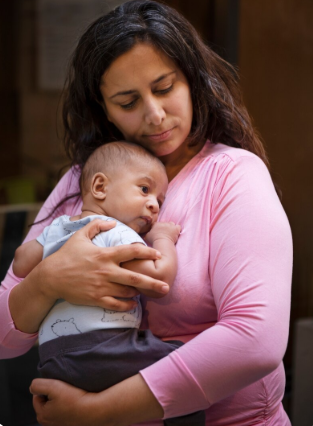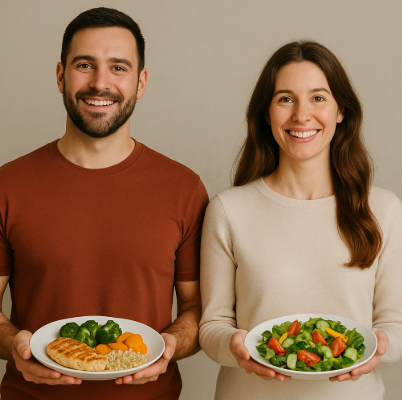Men vs Women: When it comes to health, we often speak in generic terms—eat clean, stay fit, hydrate well. But beneath these universal truths lies a powerful reality: men and women are wired differently. Biologically, emotionally, and hormonally. And these differences quietly shape our nutritional needs, body composition, and disease patterns. It’s time we honor those differences, not ignore them.
Table of Contents
Men vs Women
When we gather around the same table, eat from the same plates, and follow the same health advice—it’s easy to forget one quiet truth: men and women are not the same on the inside.
Not in how we burn energy, store fat, or absorb nutrients.
Not in how we react to stress, hormones, or hunger.
Understanding these differences is not about separation.
It’s about respecting the unique rhythm of each body, and honoring what it truly needs.
1. 🌾 Men vs Women: Nutritional Needs
💙 Men’s Needs: Strength, Stamina, & Recovery
Men generally have:
- Higher lean muscle mass – needs more protein to build and repair tissue.
- Greater calorie requirements – about 2,500–3,000 kcal/day, especially for active males.
- Higher needs for:
- Zinc (for testosterone & immunity)
- Magnesium (for muscle & nerve function)
- B-vitamins (for energy metabolism)
They may need more food, but not more junk. Sadly, many men fill this gap with processed meats, alcohol, and convenience foods.
❤️ Women’s Needs: Balance, Blood, & Bone
Women have more body fat (naturally) for reproductive and hormonal health, but:
- Lower calorie needs: around 1,800–2,200 kcal/day, depending on life stage.
- Higher demand for:
- Iron (due to menstruation)
- Calcium & Vitamin D (for bones, especially post-30)
- Folate & Omega-3s (for fertility, pregnancy, and mental health)
Why Men Need More Calories
Men have a greater calorie requirement than women mainly because of biological differences in body composition, metabolism, and hormone levels. Here’s a simple breakdown:
🔥 1. More Muscle Mass = Higher Energy Use
Men naturally have more lean muscle than women. And muscle tissue burns more calories at rest than fat.
- Even when doing nothing, a man’s body needs more energy to maintain that muscle.
- This leads to a higher Basal Metabolic Rate (BMR)—the number of calories the body burns just to stay alive.

💨 2. Faster Metabolism
Because of higher muscle mass and testosterone levels, men usually have a faster metabolism.
- They burn through energy more quickly, even during basic activities like walking or eating.
- This means they need more calories daily to maintain energy balance.
📏 3. Larger Body Size
Men are often taller and heavier, which means:
- More tissues to support
- More calories needed to power organs, muscles, and movement
🧬 4. Hormonal Influence
Testosterone in men:
- Promotes muscle growth
- Increases appetite and metabolic rate
Whereas estrogen in women:
- Encourages fat storage (especially for reproductive health)
- Slows metabolism slightly to conserve energy for fertility and childbearing
🍽️ How This Translates:
- Average man: Needs 2,500–3,000 calories/day (depending on activity level)
- Average woman: Needs 1,800–2,200 calories/day
💡 Final Thought:
It’s not about who eats more or less—it’s about what your body truly needs to thrive. Men burn more because their bodies are built for it. Women conserve more, because nature designed them for something just as powerful—creation and care.
2.🥗 Diet Differences: One Table, Two Realities
| Aspect | Men | Women |
|---|---|---|
| Calories | Higher (due to muscle mass & activity) | Lower (but nutrient-dense) |
| Protein | More (muscle repair, testosterone) | Moderate (but quality is key) |
| Carbohydrates | More allowed (greater energy use) | Controlled (watch for insulin sensitivity) |
| Fats | Moderate to high (for energy) | Essential fats crucial for hormones |
| Micronutrient Focus | Zinc, Magnesium, Vitamin D, B12 | Iron, Calcium, Folate, Omega-3, Vitamin D |
| Meal Timing | 2–3 large meals may work | 3–5 small, balanced meals preferred |
🧡 A woman eats for balance, a man often eats for performance—but both deserve nourishment with love and intention.
3. 🍽️ Men vs Women: Portion Size
👨 Men:
Because of their higher energy output, men usually need larger portions of complex carbs, protein, and healthy fats. For example:
- 1.5–2 cups of cooked grains (vs 1 cup for women)
- 2 palm-sized portions of protein (vs 1–1.5 for women)
- More nuts, seeds, and starchy vegetables to support physical activity
👩 Women:
Women need nutrient-dense, not calorie-dense meals. Portion control becomes essential to manage hormonal shifts, mood, and energy. A balance of:
- Smaller but frequent meals to regulate blood sugar
- Emphasis on fiber-rich veggies, low-GI carbs, and plant proteins
- Healthy fats (flax, chia, ghee) to support hormone health
🌸 Portion is not about less—it’s about what you really need. It’s not a punishment, it’s a kindness.
🍽️ Men vs Women Portion Size: Because Equality is Not Sameness
| Food Group | Men (Typical Portion) | Women (Typical Portion) | Why It Differs Emotionally & Biologically |
|---|---|---|---|
| Whole Grains | 🍚 1.5–2 cups cooked (e.g. rice, millets, quinoa) | 🍚 1–1.25 cups cooked | Men burn more due to muscle mass; women conserve energy for hormonal balance. |
| Vegetables | 🥦 2–3 cups per day (raw or cooked) | 🥦 2–2.5 cups per day | Women often need higher antioxidants & fiber to support hormonal health. |
| Fruits | 🍎 2 medium fruits or 1.5 cups sliced | 🍎 1–2 medium fruits or 1 cup sliced | Women benefit from iron-boosting fruits like guava, berries, amla more. |
| Protein (Legumes/Meat) | 🍗 6–8 oz (about 2 palm-sized portions per meal) | 🍗 4–6 oz (1 to 1.5 palm-sized portions per meal) | Men need more for muscle maintenance; women need moderate amounts for metabolic support. |
| Dairy / Calcium foods | 🥛 2–3 cups milk/yogurt equivalent | 🥛 3–4 cups milk/yogurt equivalent | Women need more calcium, especially during menstruation, pregnancy & menopause. |
| Healthy Fats | 🥥 6–8 tsp oils, seeds, nuts (ghee, flax, coconut, almonds) | 🥥 4–6 tsp oils, seeds, nuts | Women benefit from omega-3s for hormone regulation, but need less total fat than men. |
| Water Intake | 💧 3–4 liters/day | 💧 2.5–3 liters/day | Both need hydration, but men lose more fluids via sweat; women may need more during pregnancy/lactation. |
💖 Emotional Insight:
“Your body isn’t asking you to eat less.
It’s asking you to eat right—for your rhythm, your hormones, your heart.”
Eating the same meal size doesn’t mean fairness—it means overfeeding one and under nourishing the other. Portion is not about control. It’s about care.
4. ⚖️ Men vs Women: BMI & Body Composition
| Parameter | Men | Women |
|---|---|---|
| Average BMI Range | 18.5–24.9 (ideal); obesity risk >25 | 18.5–24.9 (ideal); obesity risk >25 |
| Muscle % | 40–50% | 30–40% |
| Fat % | 10–20% (essential ~3%) | 20–30% (essential ~10–12%) |
| Weight Focus | Muscle gain, fat control | Fat distribution, lean mass retention |
💞 Men vs Women: A Beautiful Difference in Body Composition
Our bodies are not identical—and that’s a wonderful thing. Every cell, curve, and contour tells a story of how men and women are designed differently for different purposes—both equally powerful.
Here’s a compassionate comparison that honors those differences:
| Component | Men | Women | Why This Difference Matters |
|---|---|---|---|
| Muscle Mass | 💪 Higher (≈ 40–45% of body weight) | 💪 Lower (≈ 30–35% of body weight) | Men have more testosterone, building more muscle. Women have less, as energy is stored more for nurturing life. |
| Body Fat % | 🔥 Lower (≈ 10–20%) | 🔥 Higher (≈ 20–30%) | Women carry more fat to support hormones, fertility, pregnancy, and breastfeeding—an evolutionary gift. |
| Bone Density | 🦴 Greater bone mass and size | 🦴 Slightly lower, especially post-menopause | Estrogen supports bone health. As it decreases with age, women become more prone to osteoporosis. |
| Water Content | 💧 60–65% of body weight | 💧 50–55% of body weight | Men’s higher muscle mass means they hold more water. Women’s higher fat percentage stores less water. |
| Fat Distribution | ⚖️ More around abdomen (apple-shaped) | ⚖️ More around hips & thighs (pear-shaped) | Women’s fat pattern supports childbearing; men’s abdominal fat is more associated with metabolic risk if in excess. |
| Metabolic Rate | 🔄 Faster due to more lean mass | 🔄 Slightly slower to conserve energy | Women’s metabolism slows to protect energy for menstruation, pregnancy, and survival—especially in times of scarcity. |
💖 A Loving Truth
“We are not built the same—because we’re not meant to be.
Women create life. Men protect and provide strength.
Both roles are sacred. Both bodies are perfect as they are.”
Understanding body composition isn’t about comparison—it’s about celebration. Let’s not strive to be like each other, but to be the best version of our own design.
Women naturally carry more fat for hormonal balance and childbearing. Yet, BMI doesn’t always reflect health. A muscular man and a curvy woman may both be “overweight” by BMI but deeply healthy inside.
Why Women Naturally Carry More Fat: A Biological Design
Women’s bodies are uniquely designed for reproduction, hormonal regulation, and nurturing life—and one key part of that design is body fat.
Unlike men, women naturally carry a higher percentage of body fat—often around 20–30%, compared to 10–20% in men. This isn’t just about appearance. It’s about function and survival.

💫 Here’s why this extra fat matters:
- Hormonal Balance
Fat tissue helps regulate and store hormones like estrogen, which plays a critical role in:- Menstrual health
- Fertility
- Mood and emotional stability
- Bone strength
A healthy fat level ensures these hormones stay balanced, especially during menstruation, pregnancy, and menopause.
- Childbearing & Breastfeeding
A woman’s body prepares itself for the energy demands of pregnancy and lactation. Fat becomes a reserve fuel to nourish both the mother and the growing baby, especially during times of food scarcity or physical stress. - Thermal Protection & Immunity
Women’s fat distribution (especially around hips and thighs) provides insulation and also supports immune function, helping protect against infections—especially during the vulnerable stages of pregnancy.
💖 Final Thought:
Carrying more fat is not a flaw—it’s a feminine strength. It’s part of a deep biological wisdom that has allowed women to carry life, nourish it, and thrive.
So instead of chasing the “thin ideal,” let’s celebrate a woman’s natural shape—as powerful, purposeful, and perfectly her.
🌸 A Gentle Summary: Honoring the Differences, Celebrating the Design
As we reflect on the journey of men and women through food, health, and biology, let’s remember:
- 🧬 Men burn energy faster, fueled by muscle and testosterone.
- 💫 Women conserve energy wisely, storing fat with purpose—for hormones, fertility, and nurturing life.
- 🥦 Men absorb nutrients to build strength; women need more iron, calcium, and omega‑3s to support cycles, bones, and balance.
- 🌪️ Stress hits men silently, pushing them toward physical release or withdrawal.
- 🌧️ Women feel stress deeply, where it often intertwines with emotions, hormones, and eating patterns.
- 🍽️ Hunger in men is physical fuel, in women, it’s emotional, cyclical, and deeply intuitive.
5. 💔 Men vs Women: Common Diseases: Our Battles Are Not the Same
When it comes to illness, men and women don’t just experience different diseases—they often face the same ones differently. Not because one is stronger or weaker, but because biology, hormones, and emotions shape our vulnerabilities.
- ❤️ Men are more prone to heart attacks—and at earlier ages—often missing the silent emotional signs of stress and bottling it up until it erupts.
- 💔 Women’s hearts break differently, with subtler symptoms, often dismissed or misdiagnosed, especially post-menopause when estrogen protection declines.
- 🧠 Mental health challenges manifest quietly in men—masked by anger or silence—while women are more vocal, but more vulnerable to anxiety, depression, and emotional burnout.
- 🍬 Men are more likely to develop Type 2 diabetes, often linked to abdominal fat and lifestyle, while women may face insulin resistance due to PCOS or hormonal imbalance.
- 🦴 Osteoporosis whispers louder in women, especially after 40, while men may ignore early bone loss signs until it’s too late.
- 🎗️ Autoimmune disorders like thyroid issues, lupus, or rheumatoid arthritis—are far more common in women, often linked to their complex immune and hormonal interplay.
| Health Concern | Men (Higher Risk) | Women (Higher Risk) |
|---|---|---|
| Heart Disease | Earlier onset, silent symptoms | Later onset, more fatal after menopause |
| Diabetes Type 2 | Linked with belly fat, lifestyle | Strong hormonal link (PCOS, menopause) |
| Hypertension(High BP) | More common after 45 | Often rises post-menopause |
| Osteoporosis | Less common, less screened | High risk post-40 due to estrogen drop |
| Mental Health | Underdiagnosed, hidden anxiety/depression | Higher rates of depression, eating disorders |
| Cancer Risk | Prostate, colon, liver | Breast, ovarian, thyroid |
Videos
Watch the video in Hindi on Top 12 health issues in women here and for men here.
🌿 He suffers in silence, she survives in struggle. But both deserve to be seen, heard, and healed.
💡 Disease is not just biology—it’s biography.
It’s the way we live, love, stress, rest, and nourish ourselves.
By embracing these differences with awareness and empathy, we can shift from simply treating illness to truly supporting well-being—for both men and women, in all their strength and sensitivity.
💡 A Gentle Call to Action:
Whether you are a father working late or a mother skipping meals…
A son ignoring the chest tightness or a daughter normalizing fatigue…
It’s time to listen deeply.
🫶 Health isn’t one-size-fits-all. Your body tells a unique story. Nourish it, honor it, and let it thrive.
💖 We are not meant to eat the same, feel the same, or respond the same.
We are meant to listen—to our bodies, to each other, and to the wisdom within.
Let’s not chase equality in numbers, but equity in nourishment. Because understanding our differences is not a divide—it’s a bridge to compassion, care, and lasting health.
References –
Nutrient Requirements for Indians link
Dietary guidelines for Indians link
Check Adult Diet by age here.
Check Old age diet plan here Child food & diet here.
Learn about Balanced Diet here.

1 thought on “Men vs Women: 5 Eye-Opening Facts About Diet, Nutrition, Portion Size, BMI & Diseases”